The Claas brand has been synonymous with the harvesting of grass and cereals for years. However, since its acquisition of the Renault Agriculture tractor brand in 2003 the manufacturer has made good inroads into the tractor business, particularly in the last decade.
Claas has been building its tractors at the Le Mans plant in France since the Renault acquisition. It is estimated Claas has built around 190,000 units at Le Mans since 2003.
Meanwhile, in total, Claas has built around 220,000 tractors in total, including its Xerion range and OEM tractors. Today, the site encompasses 52 acres, with 800 people employed there. The French site is responsible for the design and manufacture of 105 models, starting with the 75hp Axos and ranging right up to the 460hp Axion 900 series. Outside of this, its smaller-horsepower Nexos and Elios tractors are built by Cararro in Italy, while its high-horsepower Xerion range is manufactured at Claas HQ in Harsewinkel in Germany.
The manufacturer explained it has invested €40m in the last five years on the Le Mans plant, while a total investment of €80m has been spent there since the acquisition of Renault.
The factory
The tractor factory is on the outskirts of Le Mans in western France. Le Mans is best known for the annual 24-hour sports-car race, regarded as one of the world’s greatest auto racing events.
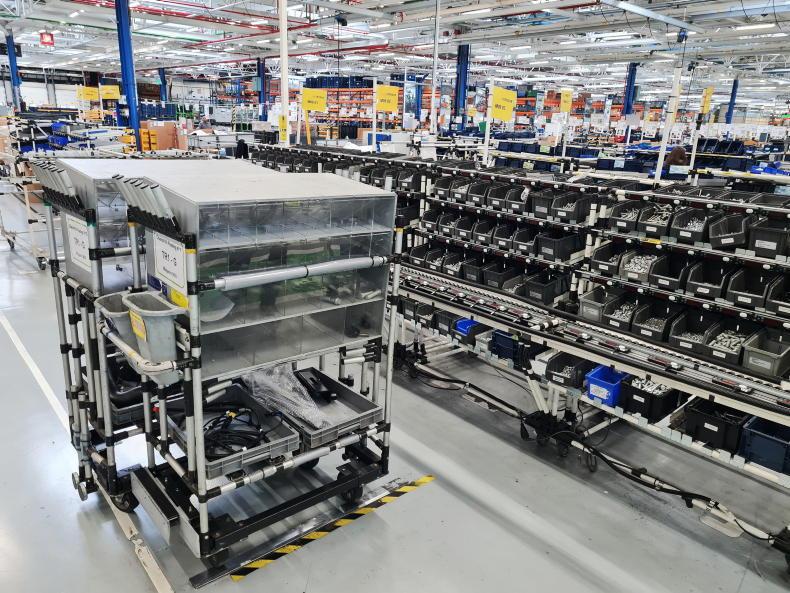
Each sub assembly operator is presented with a shopping list of components via a tablet which are scanned via barcode once collected by the operator and placed into the kit trolly.
The day we visited, 53 tractors were scheduled to be built. Claas says it has the capacity to build up to 75/units per day and 13,000 units each year. No tractors are built for stock. Every tractor that rolls off the production line has a customer. Whether it’s for dealer stock or sold to an end user, every tractor is built to order. Interestingly, one-third of production is Stage III tractors, which are destined for ‘low regulated’ markets such as Australia, eastern Europe and South Africa. These tractors are quite distinctive given that they are based on what we in the Irish and UK market would call the older Arion and Axion models from the 2007-2012 era.

Components are collected from the warehouse and placed into kits before assembly.
Upon entering the factory floor, two things struck us. Firstly, how clean and bright it was and secondly the level of automation. Automated guided vehicles (AGV) were added as part of the recent investment to modernise the facility. Forty of these driverless vehicles transport the bare chassis right through every station along the 1.3km assembly line until a completed tractor can be driven off the line. Every AGV has a carrying capacity of 20,000kg and is responsible for one tractor right through from start to finish. These AGVs are battery powered and recharges wirelessly through induction as they return from the final assembly station back to the first.
The line continuously moves without stopping unless triggered by an operator in case of an emergency.
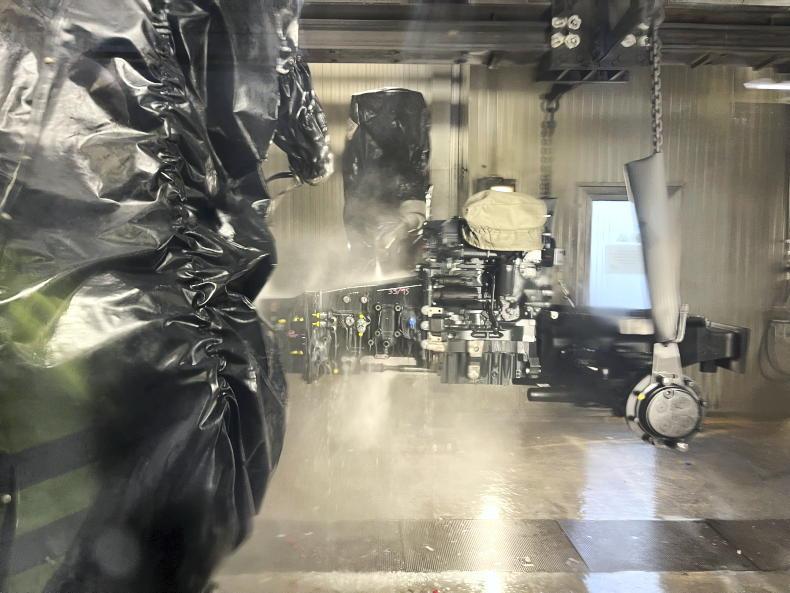
The whole washdown process ahead of painting is automated.
At each station, operators have a total of eight minutes to carry out the task they are responsible for.
During every shift, one AGV is kitted out with cleaning equipment such as hoovers and brushes. Upon arrival at each station, operators use these eight minutes to clean their work environment.
Automated warehouse
The journey for the basic componentry starts at the automated warehouse, which in layman’s terms could be compared to a supermarket. This warehouse is fed by 80 lorries each day.
Depending on the item supplier, some parts arrive loose while others arrive in assembled kits. The automated warehouse has the capacity to hold 30,000 boxes. This warehouse is autonomously loaded and unloaded, with each product weighed and scanned in and out using barcodes.
As all tractors are built to order, components required for a specific tractor are assembled into kit trolleys.

After washing and degreasing chassis's are dried and preheated before the painting.
These kit trolleys can be seen all over the plant and contain the exact number of components to form the associated sub-assembly.
Given the success of the automated warehouse, Claas said plans are in place to build another in the near future.
The manufacturer was keen to point out that automation does not replace manpower, but simplifies the workload.
Tractor assembly
The Le Mans factory is essentially an assembly hub, with no manufacturing taking place on site. Instead, the factory relies heavily on the Japanese “just in time” (JIT) process whereby parts and componentry arrive on site as needed. From start to finish it takes three days for a tractor to make its way through the factory – from assembly to paint to testing and final validation.
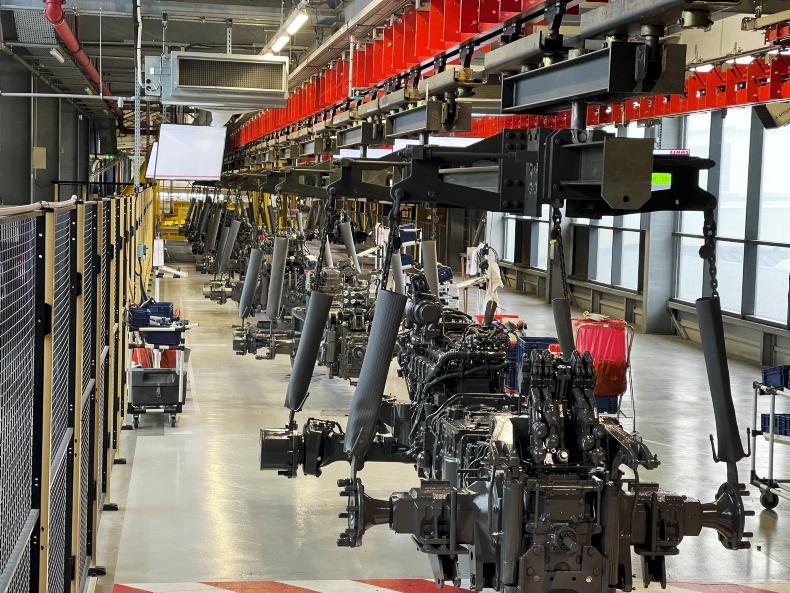
The paint process uses a hybrid approach of robots and manual painters.
The assembly process is comparable to a fish spine, with the main assembly line being the backbone and each of the sub-assembly areas serving as the smaller bones feeding into the backbone.
To aid efficiency, each sub-assembly is positioned right beside the main line. All component certification is carried out by the supplier. Claas requires certified engineers from all of its suppliers to work in its factory, ensuring all products meet its strict quality requirements.
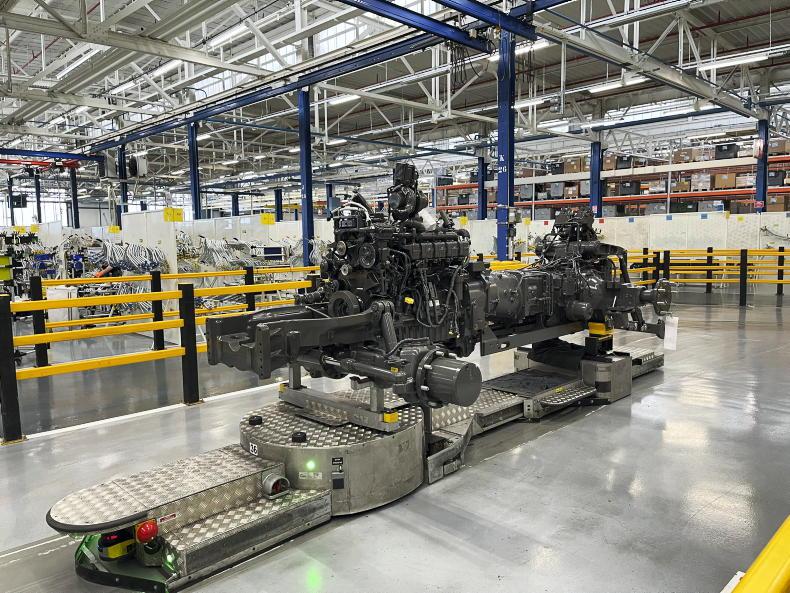
The AGV automatically adjusts to suit the wheelbase of the tractor model in which it will carry around the 1.3km assembly line.
At each station throughout the factory floor, there is a large screen. These screens display the target number of tractors to be built during that particular shift, the live target as well as the actual number built. The remaining time operators have to complete their given task is also displayed.
Once the chassis, engine and transmission has been assembled, the unit is sent to be pressure-washed, rinsed three times and degreased before entering the priming and paint process. The entire washing and cleaning process is carried out using robots. Chassis are then dried using a machine resembling a big hairdryer, and pre-heated in an oven at 80°C before the paint process. This is carried out using a hybrid approach, through a mix of robots and manual painters.

Autonomous forklifts collect the tyres and rims, and bring them over to the assembly line for fitment.
One thing we noticed with the assembly line, similar to the Massey Ferguson factory, was the sequence in which tractors were built. It wasn’t a case of the same models being assembled in a row. Instead, it was from one extreme to another in terms of spec and size.
This is for smooth operation of the assembly line from a labour perspective. The logic is simple – a smaller-horsepower basic tractor takes less time at each station compared to a more complex larger 450hp tractor, allowing operators to balance their time accordingly.

One of the early stages of assembly is the marrying up of the engine and transaxle.
After the cab has been fitted, one of the final stages of assembly is the fitting of wheels. Autonomous robots even collect the tyres and rims, and bring them over to the assembly line.
The main assembly line operates one shift daily, five days each week, starting at 6.30am and finishing at 3.30pm.
Quality checks
Claas takes a serious approach to ensuring there are no mistakes are made during assembly. When it comes to tools such as impact guns, they will only engage when set up in the correct sequence. Every time such a tool is used, the time, the operator and the torque are measured and recorded. This means there is total traceability in the factory.

Cabs are loaded via forklift onto a separate assembly line having arrived as a bare steel structures with the windows fitted.
Every morning, operators calibrate the tools to ensure they have the correct torque. Once a month, the tooling is inspected internally, with a full external audit taking place annually.
The quality process differs from most factories in that the operator answers a number of questions on screen in terms what they see and not what they should see.
Claas believes this technique keeps the quality check department more alert and the process more accurate, reducing the chances of potential error. In the event that there is an issue, it is then solved on the line without the tractor being removed.
What componentry do Claas use?
Claas uses GIMA-built Hexashift powershift transmissions and a mix of its own Cmatic CVT and ZF CVT transmissions.
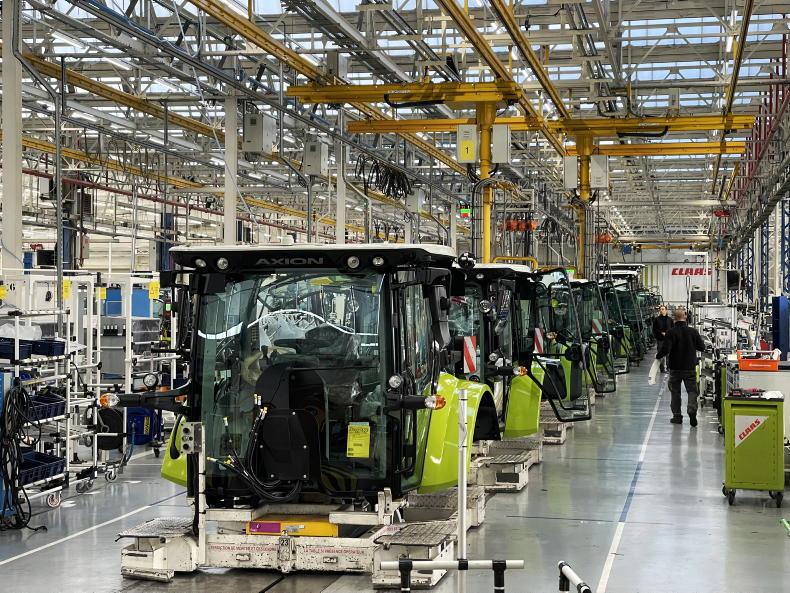
Completed cabs are delivered to the main assembly line in the corresponding sequence to the chassis'.
GIMA originated in 1994 as a joint venture between AGCO and Renault. Today, GIMA is a 50-50 joint venture between AGCO and Claas. It’s located in Beauvais at the Massey Ferguson tractor factory, which is 300km away from Le Mans. GIMA develops and builds powershift transmissions and rear axles for tractors, ranging from 55hp up to 620hp. This includes the Dyna 4 and Dyna 6 transmissions for Massey Fergusson and the Hexashift transmissions for Claas.

At each station operators have a total of eight minutes to carry out the task they are responsible for.
GIMA can build up to 24,000 transmissions annually. GIMA transmissions are fitted to more than 400,000 tractors worldwide. Roughly 50% of the transmissions built daily are for MF, while the remaining 50% are split between Claas and Valtra.

Up to 500 tractors can be on site at any one time awaiting transport.
In 2015, Claas introduced its own EQ stepless infinitely variable transmission which it uses in its Arion 500 and 600 Cmatic models.

One of the final steps is the fitting of the wheels which arrive to the assembly line via separate AGVs.
This is built at Claas Industrietechnik (CIT) at Paderborn in Germany. Earlier this year, Claas produced its 10,000th EQ transmission. SDF also recently completed a deal with Claas to use the EQ continuously variable transmissions in the Deutz TTV drivetrain.

The Axion 900 series Terra Trac models are road tested as part of final validation before delivery.
For its larger horsepower Axion range, Claas uses a ZF infinitely variable transmission. Meanwhile, it uses Fiat Powertrain Technologies (FPT) and Deere Power Systems (DPS) engines, Dana Spicer and Cararro front axles and sources its front-end loader from MX, 150km from Le Mans.
Claas buys in the raw cab frame, fitted with glass. At the factory, the cab is fully assembled, followed by the testing of all its functions.
The fully assembled cab then meets the chassis it is destined for at the correct station and is fitted in less than eight minutes.
Most popular models and markets
Claas exports tractors to over 80 countries worldwide. France is the number one market, followed by Germany in second, which combined account for 50% of all Claas tractor sales. The UK and Ireland is the third most popular market for Claas tractors.
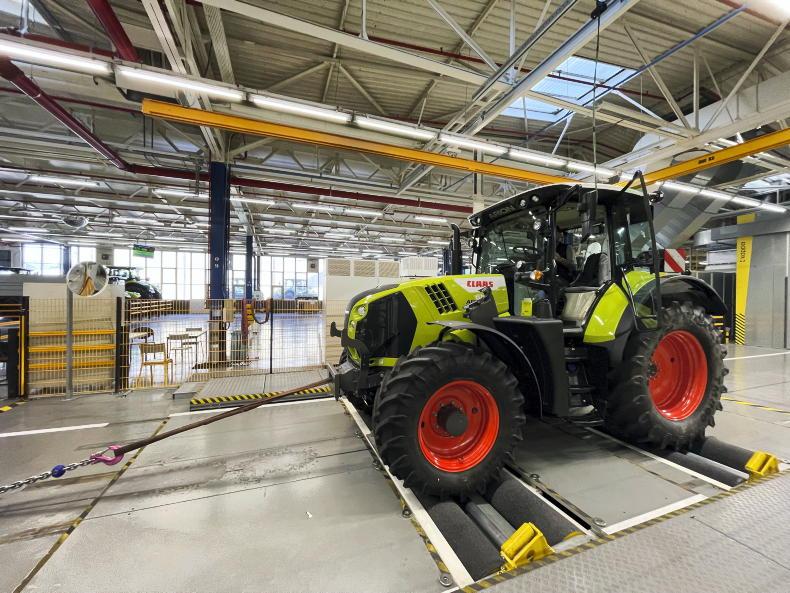
Each tractor is dyno tested as part of final validation to simulate varying loads and work conditions.
According to the team at the plant, the Arion 630 and the 650 are the two most popular models on the production line. Powershift is the most popular transmission, but Claas noted that its Cmatic CVT transmission is quickly growing in popularity, and currently accounts for one-third of total production.
History – Renault
The Le Mans tractor factory came as part of the deal when Claas acquired the Renault brand in 2003. Prior to the Le Mans site, Renault had been building tractors in Billancourt on the outskirts of Paris where it also built cars at the time. In 1938 the Le Mans site was established, with the first tractor rolling off the line in 1942. By 1952, Renault had a 58% market share of tractor sales in its home market.
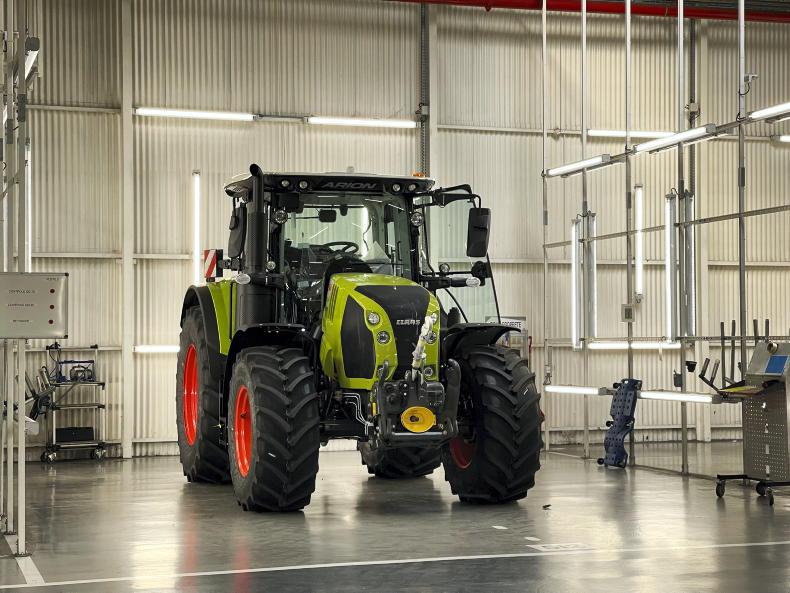
Each tractor is visually examined for any potential flaws or issues.
In 2017 the production site at Le Mans underwent a €40m investment. This investment included a digital transformation and the complete renewal of the assembly equipment. The latter is said to have been managed by employees from the assembly lines given their familiarity with the process. The result is one of Europe’s most modern tractor productions facilities. This year, the factory won a national French factory of the future award.
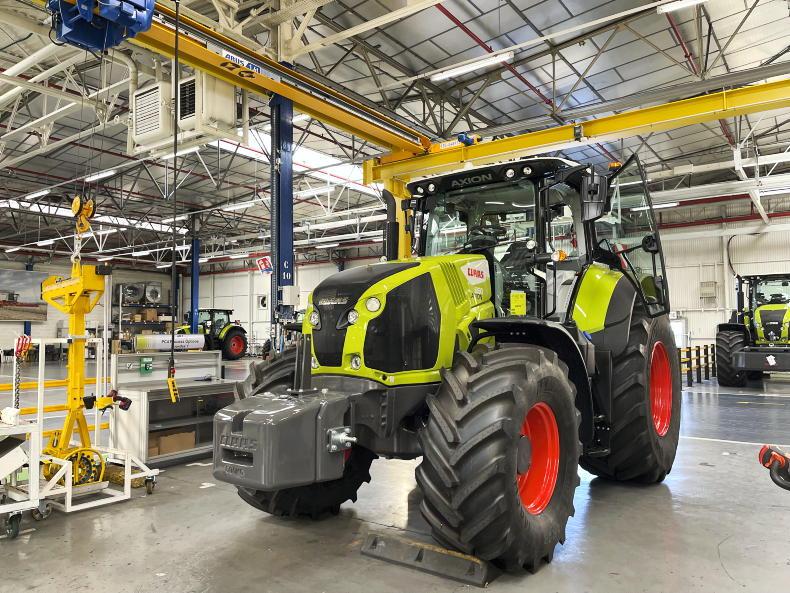
Heavy accessories such as weights are fitted last.
Factory
key facts
Le Mans site covers 52 acres. Claas employs 800 staff at Le Mans. Five model ranges built from 75hp to 460hp. Capacity to build up to 75 tractors daily. Main assembly line is 1.3km long. The Arion 630 and the 650 are the two most popular models. There are 105 model variants built at the factory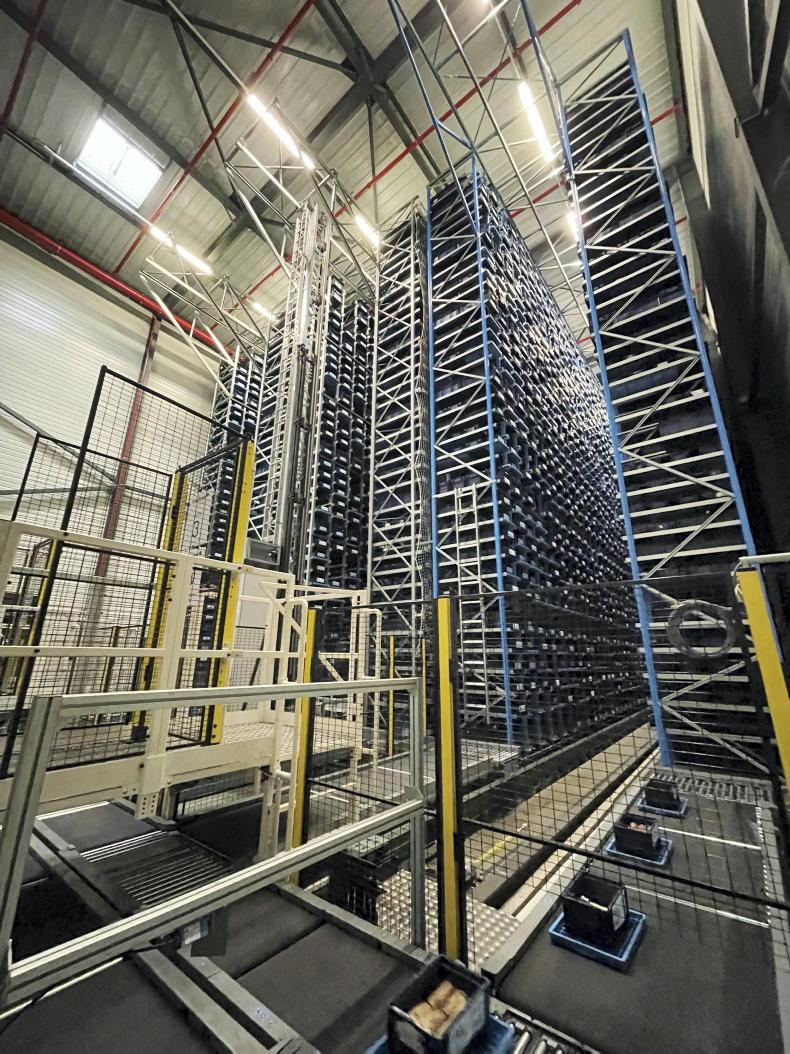
The automated warehouse has the capacity to store 30,000 boxes.
The Claas brand has been synonymous with the harvesting of grass and cereals for years. However, since its acquisition of the Renault Agriculture tractor brand in 2003 the manufacturer has made good inroads into the tractor business, particularly in the last decade.
Claas has been building its tractors at the Le Mans plant in France since the Renault acquisition. It is estimated Claas has built around 190,000 units at Le Mans since 2003.
Meanwhile, in total, Claas has built around 220,000 tractors in total, including its Xerion range and OEM tractors. Today, the site encompasses 52 acres, with 800 people employed there. The French site is responsible for the design and manufacture of 105 models, starting with the 75hp Axos and ranging right up to the 460hp Axion 900 series. Outside of this, its smaller-horsepower Nexos and Elios tractors are built by Cararro in Italy, while its high-horsepower Xerion range is manufactured at Claas HQ in Harsewinkel in Germany.
The manufacturer explained it has invested €40m in the last five years on the Le Mans plant, while a total investment of €80m has been spent there since the acquisition of Renault.
The factory
The tractor factory is on the outskirts of Le Mans in western France. Le Mans is best known for the annual 24-hour sports-car race, regarded as one of the world’s greatest auto racing events.

Each sub assembly operator is presented with a shopping list of components via a tablet which are scanned via barcode once collected by the operator and placed into the kit trolly.
The day we visited, 53 tractors were scheduled to be built. Claas says it has the capacity to build up to 75/units per day and 13,000 units each year. No tractors are built for stock. Every tractor that rolls off the production line has a customer. Whether it’s for dealer stock or sold to an end user, every tractor is built to order. Interestingly, one-third of production is Stage III tractors, which are destined for ‘low regulated’ markets such as Australia, eastern Europe and South Africa. These tractors are quite distinctive given that they are based on what we in the Irish and UK market would call the older Arion and Axion models from the 2007-2012 era.

Components are collected from the warehouse and placed into kits before assembly.
Upon entering the factory floor, two things struck us. Firstly, how clean and bright it was and secondly the level of automation. Automated guided vehicles (AGV) were added as part of the recent investment to modernise the facility. Forty of these driverless vehicles transport the bare chassis right through every station along the 1.3km assembly line until a completed tractor can be driven off the line. Every AGV has a carrying capacity of 20,000kg and is responsible for one tractor right through from start to finish. These AGVs are battery powered and recharges wirelessly through induction as they return from the final assembly station back to the first.
The line continuously moves without stopping unless triggered by an operator in case of an emergency.

The whole washdown process ahead of painting is automated.
At each station, operators have a total of eight minutes to carry out the task they are responsible for.
During every shift, one AGV is kitted out with cleaning equipment such as hoovers and brushes. Upon arrival at each station, operators use these eight minutes to clean their work environment.
Automated warehouse
The journey for the basic componentry starts at the automated warehouse, which in layman’s terms could be compared to a supermarket. This warehouse is fed by 80 lorries each day.
Depending on the item supplier, some parts arrive loose while others arrive in assembled kits. The automated warehouse has the capacity to hold 30,000 boxes. This warehouse is autonomously loaded and unloaded, with each product weighed and scanned in and out using barcodes.
As all tractors are built to order, components required for a specific tractor are assembled into kit trolleys.

After washing and degreasing chassis's are dried and preheated before the painting.
These kit trolleys can be seen all over the plant and contain the exact number of components to form the associated sub-assembly.
Given the success of the automated warehouse, Claas said plans are in place to build another in the near future.
The manufacturer was keen to point out that automation does not replace manpower, but simplifies the workload.
Tractor assembly
The Le Mans factory is essentially an assembly hub, with no manufacturing taking place on site. Instead, the factory relies heavily on the Japanese “just in time” (JIT) process whereby parts and componentry arrive on site as needed. From start to finish it takes three days for a tractor to make its way through the factory – from assembly to paint to testing and final validation.

The paint process uses a hybrid approach of robots and manual painters.
The assembly process is comparable to a fish spine, with the main assembly line being the backbone and each of the sub-assembly areas serving as the smaller bones feeding into the backbone.
To aid efficiency, each sub-assembly is positioned right beside the main line. All component certification is carried out by the supplier. Claas requires certified engineers from all of its suppliers to work in its factory, ensuring all products meet its strict quality requirements.

The AGV automatically adjusts to suit the wheelbase of the tractor model in which it will carry around the 1.3km assembly line.
At each station throughout the factory floor, there is a large screen. These screens display the target number of tractors to be built during that particular shift, the live target as well as the actual number built. The remaining time operators have to complete their given task is also displayed.
Once the chassis, engine and transmission has been assembled, the unit is sent to be pressure-washed, rinsed three times and degreased before entering the priming and paint process. The entire washing and cleaning process is carried out using robots. Chassis are then dried using a machine resembling a big hairdryer, and pre-heated in an oven at 80°C before the paint process. This is carried out using a hybrid approach, through a mix of robots and manual painters.

Autonomous forklifts collect the tyres and rims, and bring them over to the assembly line for fitment.
One thing we noticed with the assembly line, similar to the Massey Ferguson factory, was the sequence in which tractors were built. It wasn’t a case of the same models being assembled in a row. Instead, it was from one extreme to another in terms of spec and size.
This is for smooth operation of the assembly line from a labour perspective. The logic is simple – a smaller-horsepower basic tractor takes less time at each station compared to a more complex larger 450hp tractor, allowing operators to balance their time accordingly.

One of the early stages of assembly is the marrying up of the engine and transaxle.
After the cab has been fitted, one of the final stages of assembly is the fitting of wheels. Autonomous robots even collect the tyres and rims, and bring them over to the assembly line.
The main assembly line operates one shift daily, five days each week, starting at 6.30am and finishing at 3.30pm.
Quality checks
Claas takes a serious approach to ensuring there are no mistakes are made during assembly. When it comes to tools such as impact guns, they will only engage when set up in the correct sequence. Every time such a tool is used, the time, the operator and the torque are measured and recorded. This means there is total traceability in the factory.

Cabs are loaded via forklift onto a separate assembly line having arrived as a bare steel structures with the windows fitted.
Every morning, operators calibrate the tools to ensure they have the correct torque. Once a month, the tooling is inspected internally, with a full external audit taking place annually.
The quality process differs from most factories in that the operator answers a number of questions on screen in terms what they see and not what they should see.
Claas believes this technique keeps the quality check department more alert and the process more accurate, reducing the chances of potential error. In the event that there is an issue, it is then solved on the line without the tractor being removed.
What componentry do Claas use?
Claas uses GIMA-built Hexashift powershift transmissions and a mix of its own Cmatic CVT and ZF CVT transmissions.

Completed cabs are delivered to the main assembly line in the corresponding sequence to the chassis'.
GIMA originated in 1994 as a joint venture between AGCO and Renault. Today, GIMA is a 50-50 joint venture between AGCO and Claas. It’s located in Beauvais at the Massey Ferguson tractor factory, which is 300km away from Le Mans. GIMA develops and builds powershift transmissions and rear axles for tractors, ranging from 55hp up to 620hp. This includes the Dyna 4 and Dyna 6 transmissions for Massey Fergusson and the Hexashift transmissions for Claas.

At each station operators have a total of eight minutes to carry out the task they are responsible for.
GIMA can build up to 24,000 transmissions annually. GIMA transmissions are fitted to more than 400,000 tractors worldwide. Roughly 50% of the transmissions built daily are for MF, while the remaining 50% are split between Claas and Valtra.

Up to 500 tractors can be on site at any one time awaiting transport.
In 2015, Claas introduced its own EQ stepless infinitely variable transmission which it uses in its Arion 500 and 600 Cmatic models.

One of the final steps is the fitting of the wheels which arrive to the assembly line via separate AGVs.
This is built at Claas Industrietechnik (CIT) at Paderborn in Germany. Earlier this year, Claas produced its 10,000th EQ transmission. SDF also recently completed a deal with Claas to use the EQ continuously variable transmissions in the Deutz TTV drivetrain.

The Axion 900 series Terra Trac models are road tested as part of final validation before delivery.
For its larger horsepower Axion range, Claas uses a ZF infinitely variable transmission. Meanwhile, it uses Fiat Powertrain Technologies (FPT) and Deere Power Systems (DPS) engines, Dana Spicer and Cararro front axles and sources its front-end loader from MX, 150km from Le Mans.
Claas buys in the raw cab frame, fitted with glass. At the factory, the cab is fully assembled, followed by the testing of all its functions.
The fully assembled cab then meets the chassis it is destined for at the correct station and is fitted in less than eight minutes.
Most popular models and markets
Claas exports tractors to over 80 countries worldwide. France is the number one market, followed by Germany in second, which combined account for 50% of all Claas tractor sales. The UK and Ireland is the third most popular market for Claas tractors.

Each tractor is dyno tested as part of final validation to simulate varying loads and work conditions.
According to the team at the plant, the Arion 630 and the 650 are the two most popular models on the production line. Powershift is the most popular transmission, but Claas noted that its Cmatic CVT transmission is quickly growing in popularity, and currently accounts for one-third of total production.
History – Renault
The Le Mans tractor factory came as part of the deal when Claas acquired the Renault brand in 2003. Prior to the Le Mans site, Renault had been building tractors in Billancourt on the outskirts of Paris where it also built cars at the time. In 1938 the Le Mans site was established, with the first tractor rolling off the line in 1942. By 1952, Renault had a 58% market share of tractor sales in its home market.

Each tractor is visually examined for any potential flaws or issues.
In 2017 the production site at Le Mans underwent a €40m investment. This investment included a digital transformation and the complete renewal of the assembly equipment. The latter is said to have been managed by employees from the assembly lines given their familiarity with the process. The result is one of Europe’s most modern tractor productions facilities. This year, the factory won a national French factory of the future award.

Heavy accessories such as weights are fitted last.
Factory
key facts
Le Mans site covers 52 acres. Claas employs 800 staff at Le Mans. Five model ranges built from 75hp to 460hp. Capacity to build up to 75 tractors daily. Main assembly line is 1.3km long. The Arion 630 and the 650 are the two most popular models. There are 105 model variants built at the factory
The automated warehouse has the capacity to store 30,000 boxes.
























 This is a subscriber-only article
This is a subscriber-only article










SHARING OPTIONS: